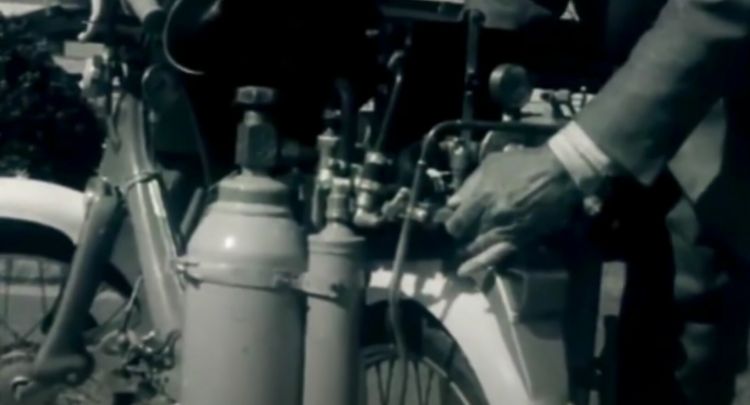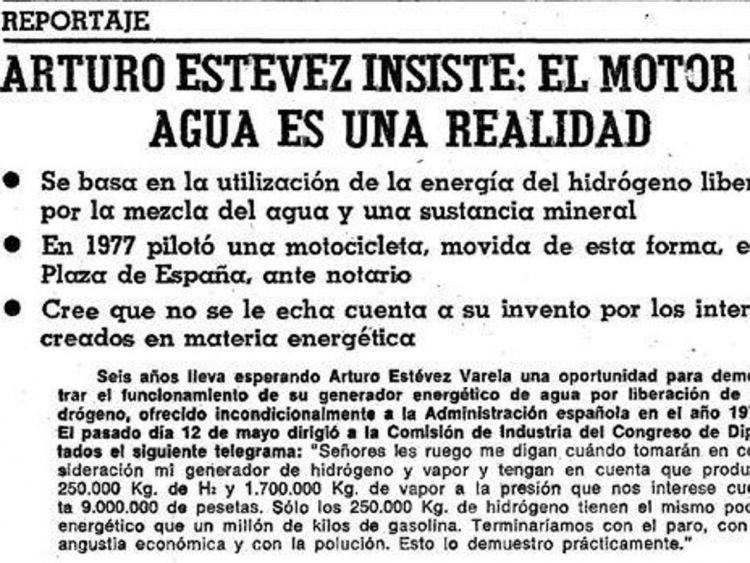We recovered this story as a continuation of our report The water motor: a Spanish invention from 50 years ago that could change everything, or not whose reading is more than recommended.
“The inventor from Extremadura, Mr. Estévez Varela, has shown once again that his water motor is not a hoax”. Thus began one of Arturo Estévez’s appearances in the 1970s in the Spanish Cinematographic News, better known as NO-DO, which RTVE would recover decades later to prepare the report that you can see in this article.
A story that we have already covered in Diariomotor, with the article by my colleague José Luis on the water motor, the Spanish invention from 50 years ago that could have changed everything, or not.
Being this a must-read article that led me these days to come across another video report that presents us with some of the keys about the history of the water engine. Keys and sufficient arguments so that the viewer can base an opinion on the matter and consider if it was ridiculous, as Francisco Franco is said to have mentioned to try to prevent the matter from being discussed again; unviable, as defended by some experts today; or an engine concept that was half a century ahead of the industry.
Arturo Estévez’s water (or hydrogen) engine continues to arouse legend and fascination in equal parts today, at a time when hydrogen is on everyone’s lips as an effective instrument for the energy transition
Arturo Estévez’s water (or hydrogen) engine
Today hydrogen and electric cars are on everyone’s lips. The future is only understood through electric cars that will work using energy stored in batteries, or the electrical energy produced in a fuel cell that consumes hydrogen, preferably green hydrogen. Along the way, many other alternatives have emerged, neutral synthetic fuels, or even internal combustion engines adapted to run on hydrogen.
And it’s no secret that Arturo Estévez’s water engine was actually very similar to the latter, a hydrogen engine that was associated with a generator that transformed waterwhich Arturo himself drank and then poured from a jug into the tank of the motorcycle with which he carried out his exhibitions, in hydrogen.
A motorcycle that had been adapted, first, so that its internal combustion engine ran on hydrogen. And secondly, to obtain that hydrogen from the reaction produced between the water in the reservoir and a mysterious mineral that, without a doubt, is largely responsible for the history of Arturo Estévez’s water motor that has survived to this day surrounded by legend and fascination with equal parts.
Arturo Estévez’s invention consisted of a generator, which transformed water into hydrogen using a mineral, and a four-stroke engine modified to run on hydrogen
Turning water into hydrogen
Transforming water into hydrogen using a mineral, and not other solutions such as electrolysis, was not a hoax. In fact, two options are considered that, in their day, were considered the true secret of Estévez:
- The first, and the one that the Regime would have determined before the expectation generated by the invention of the water motor, that it was boron. A mineral that even today is still very expensive, to the point where a trip of 100 kilometers on this motorcycle could exceed €4,000.
- The second theory, that it was ferrosilicona solution to transform hydrogen into water that would also have been used in hydrogen generators of the military industry of the time, which would be much more accessible and cheaper.
Be that as it may, It is hard to imagine that the project could have been viable. As we said, today there are many manufacturers that are betting on hydrogen, associated with a fuel cell to power an electric motor that can move a vehicle. Hydrogen still presents some problems, such as its cost and its availability, which in the future are expected to be resolved through an entire economy built around hydrogen.
Other manufacturers are even coming to propose ideas closer to that of Arturo Estévez. That although it is true that it does not transform water into hydrogen in the vehicle itself, they would be designed to refuel hydrogen and use it to feed an internal combustion engine. An interesting solution, as it would give a second life to internal combustion engines in the future, but not without added problems, such as being much less efficient than the fuel cell.



